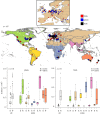A global analysis of the impacts of urbanization on bird and plant diversity reveals key anthropogenic drivers
- PMID: 24523278
- PMCID: PMC4027400
- DOI: 10.1098/rspb.2013.3330
A global analysis of the impacts of urbanization on bird and plant diversity reveals key anthropogenic drivers
Abstract
Urbanization contributes to the loss of the world's biodiversity and the homogenization of its biota. However, comparative studies of urban biodiversity leading to robust generalities of the status and drivers of biodiversity in cities at the global scale are lacking. Here, we compiled the largest global dataset to date of two diverse taxa in cities: birds (54 cities) and plants (110 cities). We found that the majority of urban bird and plant species are native in the world's cities. Few plants and birds are cosmopolitan, the most common being Columba livia and Poa annua. The density of bird and plant species (the number of species per km(2)) has declined substantially: only 8% of native bird and 25% of native plant species are currently present compared with estimates of non-urban density of species. The current density of species in cities and the loss in density of species was best explained by anthropogenic features (landcover, city age) rather than by non-anthropogenic factors (geography, climate, topography). As urbanization continues to expand, efforts directed towards the conservation of intact vegetation within urban landscapes could support higher concentrations of both bird and plant species. Despite declines in the density of species, cities still retain endemic native species, thus providing opportunities for regional and global biodiversity conservation, restoration and education.
Keywords: anthropogenic activities; density of species; global biodiversity; native species; urbanization.
Figures


References
-
- UN. 2011. World population prospects: the 2010 revision. New York, NY: UN.
-
- Schneider A, Friedl MA, Potere D. 2010. Mapping global urban areas using MODIS 500-m data: new methods and datasets. Remote Sens. Environ. 114, 1733–1746. (10.1016/j.rse.2010.03.003) - DOI
-
- Kühn I, Brandl R, Klotz S. 2004. The flora of German cities is naturally species rich. Evol. Ecol. Res. 6, 749–764.
Publication types
MeSH terms
LinkOut - more resources
Full Text Sources
Other Literature Sources
Research Materials

